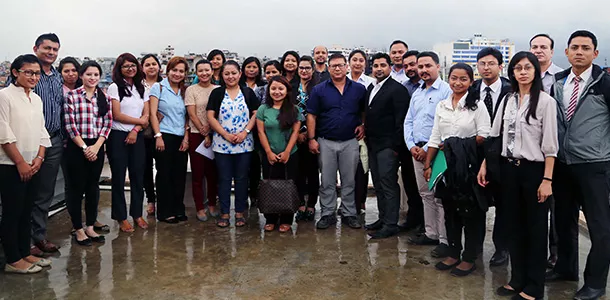
The How’s and Why’s of Job Evaluation, Discussed at 80th HR Kurakani
Category: HR Kurakani | Date: July 3, 2019, 3:35 p.m. | Total Views: 1397
HR Kurakani, an open platform organized since past eight years by Real Solutions successfully completed its 80th editions focused on the topic “The How’s and Why’s of Job Evaluation" on June 26th, 2019 at Sipradi Trading Pvt. Ltd. 50+ HR Practitioners from different organizations participated in the discussion program.
Ms. Jyotsna Shrestha, Business Manager at Real Solutions Pvt. Ltd. welcomed all participants with brief summary of HR Kurakani, followed by presentation of the international guests from Birches Group, Mr. Ernest Bacani and Ms. Janine De Guzman. The presentation highlighted the insight of Job Evaluation followed by case studies and several exercises.
Job Evaluation is a systematic, formal technique used to establish the relative worth of jobs in a job hierarchy. Job evaluation is often taken as foundation for effective and fair pay framework. “Job evaluation is important to have a bigger picture of the organization, organizing jobs, management of talents, promote Learning and Development and reward the employees for their performance. “said Ms. Ernest. Job Evaluation attempts to make a methodical comparison between jobs to assess their relative worth with the purpose of establishing a rational pay structure
Moving forward with Kurakani, Mr. Ernest and Ms. Janine shared the frameworks that the Birches Group used in their consulting services. “We at Birches group focus that Jobs are at center of organization because without job the organization cannot function, that’s why jobs matter and they should be the center of an organization.” Mr. Ernest Added. The jobs in the market, Job evaluation and salary scale speaks of your structure. Once you have organized the job and salary structure you can optimize your capacity.
An Interesting point made here was that the organizations should be organized around jobs and not people. When we hire for the job it will be defined in the context of specific job with no direct anticipation of advancement and promotion. Determining the place of job in an organization is another important component of Job Evaluation. How an organization defines the unit of work (a job) affects how it defines: Teams and Structures, Internal and External Value, Recognition and Reward which forms the foundation for HR policies and practices.
Job Evaluation Framework and its Methodology:
The job evaluation frameworks as shared in the Kurakani by Ms. Janine and Mr. Ernest are composed of four blocks:
- Common Factors of Evaluation
- Value of workplace
- Job Families
- Targeted Job Definitions
Job Evaluation is not a scientific process. The success of the Job Evaluation Methodology depends on its consistent application and context/relativity to the organization. The correctness of the results that the job evaluation provides can only be assessed in terms of their acceptability among the vast majority of people to whom it applies. It is very important to be able to justify the judgements made about the job and to make sure that the process is systematic.
The foundation of most job evaluation methodologies is to define what aspects of the job are to be examined and to define its place in the hierarchy. Job evaluations aren't a one-size-fits-all proposition. Every person who works at an organization makes a unique contribution to the business, so job reviews should reflect individual situations. Here are the general job evaluation factors that can be used to assess the progress of virtually every employee in your organization:
Purpose : This factor measures the substantive focus of the job encompassing the scope, depth and difficulty of the work.
Engagement : This factor measures the focus of interaction both internally and externally needed to deliver a service, seek collaboration and build effective partnerships
Delivery: This factor measures the focus on the execution of work and the role on the team for supporting business/operational functions.
The factors such as qualification, experience, volume of work and rare skills are not included in the Job evaluation factors of Birches Group as they do not define the complexity of the job that they are hired for. “A person is hired for the job, the number of experience, education, volume of work and rare skill that s/he has doesn’t denote If s/he can do more complex job than the others performing the same job. However, we cannot reject the fact that these factors are important while looking at the application.” Ms. Janine added.
Once you have the common factors in place, you can now see how that would apply to the organization and how would you differentiate different jobs in the company and distinguish the complexity of the jobs. In order to do that the jobs are segregated based on The Generic Community Progression where the community represents universally observable, significantly different groupings of work. The groups are further divided into How jobs and Why Jobs. How Jobs are process oriented that executes transactions driven by guidelines whereas, the Why Jobs These jobs are ones that lead the organization, formulate policies and create the process.
The How Jobs and Why Jobs should be complementary as the why jobs cannot function without the how jobs and vice versa. The How and Why jobs are then further subdivided into four clusters: General, Process, Design and Leadership. The How Jobs are composed of General and process cluster whereas the Why Jobs composed of Design and Leadership.
Here, the General Cluster is focused on providing services that requires basic of manual support and operation of equipment’s or machines, Process cluster is focused on implementation of rules and processes in their department, Design Clusters is the entry level development roles and Leadership cluster is the Sr. level roles that focuses on the programme and organizational leadership and expert roles. Once the baselines are set (Common Factors and level), the job families and targeted job definition can be established inside the organization.
After brief introductions of the job evaluation frameworks the participants of the Kurakani participated in a Job Evaluation exercise that allowed them to quickly apply their learnings. After further discussions it was agreed upon that, while evaluating the job one needs to be mindful of context: What are the jobs above it? Below it? and What are its peers? “When we have the job evaluation in place we know the purpose of the jobs which then enable us to design the structure of the organization” they added.



